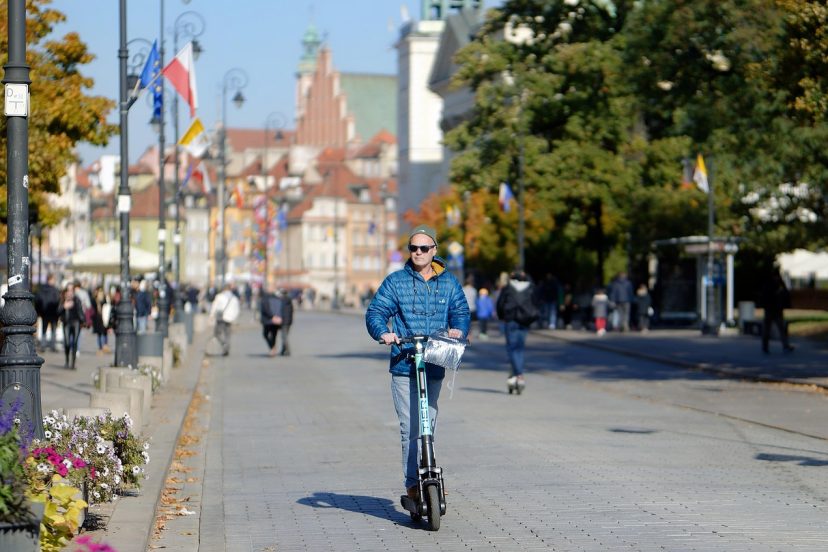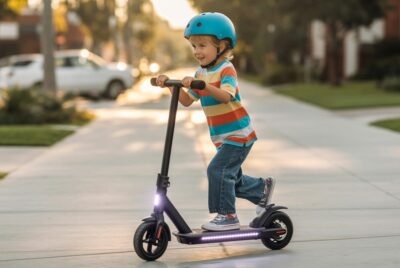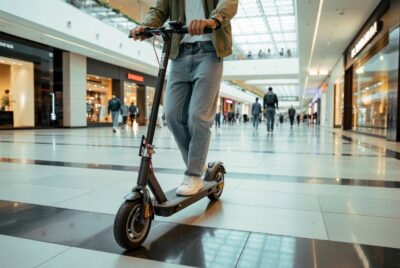How Electric Scooter Works: The Complete Guide
*We may earn a commission for purchases made using our links. Please see our disclosure to learn more.
Electric scooters have revolutionized urban transportation, offering a clean, efficient, and convenient way to navigate city streets. But have you ever wondered what happens when you press that throttle button? The intricate dance of electrical components, mechanical systems, and smart technology creates the smooth, silent ride that millions of people now depend on daily.
Understanding how electric scooters work isn’t just about satisfying curiosity—it’s about making informed decisions when purchasing, maintaining, and safely operating these modern marvels of engineering. Whether you’re considering your first electric scooter or looking to deepen your knowledge of electric vehicle technology, this comprehensive guide will take you through every component and system that makes electric scooters tick.
“Electric scooters represent a perfect blend of simplicity and sophistication, where centuries-old principles of mechanics meet cutting-edge battery and motor technology.”
– Institute of Electrical and Electronics Engineers
Key Takeaways
- Battery System: Lithium-ion batteries power electric scooters through sophisticated battery management systems that regulate charging, discharging, and thermal control
- Motor Technology: Brushless DC motors provide efficient, quiet propulsion with minimal maintenance requirements
- Control Systems: Electronic speed controllers manage power delivery, regenerative braking, and safety features
- Mechanical Components: Traditional scooter elements like wheels, brakes, and suspension work in harmony with electrical systems
- Smart Features: Modern electric scooters integrate mobile connectivity, GPS tracking, and advanced safety systems
Recommended Electric Scooters
1. High-Performance Commuter Scooter
The Hiboy S2 Pro Electric Scooter offers a powerful 500W motor that can reach speeds up to 19 mph. Its high-capacity battery supports up to 25.6 miles per charge, with an extended range option up to 40 miles. The scooter features 10-inch solid tires and dual rear shock absorbers for a smooth ride on rough roads. It folds easily for storage and transport, making it ideal for daily commuters. Safety is enhanced with bright headlights and a dual braking system including disc brakes and regenerative anti-lock brakes. An optional seat is available for added comfort. Connect to the Hiboy app to customize settings and secure your scooter.
Electric scooters like the Hiboy S2 Pro use a rechargeable battery to power a motor built into the wheel hub. When you twist the throttle, electricity flows from the battery to the motor, turning the wheels and propelling you forward. The scooter’s brakes use a combination of disc brakes and electric anti-lock systems to stop safely. Suspension and solid tires absorb bumps, making the ride smoother. The scooter folds up for easy storage, and an app lets you control speed and lock it for security. This simple but effective system shows how electric scooters work to provide fast, eco-friendly transport.
- Speed: Fast 19 mph top speed for quick commuting
- Comfort: Solid tires and shocks provide a smooth ride
- Portability: Lightweight and foldable for easy carrying
- Range: Actual distance varies by weight and terrain
- Seat: Comfortable seat sold separately
- Weight Limit: Max 220 lbs capacity
2. Lightweight Portable Model
The Widoway Electric Scooter packs a 500W motor that reaches speeds up to 19 mph, perfect for fast and efficient urban commuting. It offers a travel range between 17 and 21 miles on a single charge, depending on rider weight and terrain. Featuring an 8.5-inch honeycomb solid tire design, it provides a smooth ride without the hassle of maintenance or flats. The lightweight aluminum frame folds quickly for easy storage or transport, weighing only 26 pounds.
Electric scooters like the Widoway use a rechargeable lithium-ion battery to power a 500W electric motor inside the wheel hub. When you accelerate, the battery sends electricity to the motor, which spins the wheels and propels the scooter forward. Speed and power depend on the battery charge and rider weight. The scooter’s dual braking system combines electric anti-lock brakes with a mechanical disc brake for safe stopping. The honeycomb solid tires absorb bumps without flats, while the foldable aluminum frame makes it easy to carry and store. Connected apps add convenience by letting you control speed settings and lock your scooter remotely. This simple system explains how electric scooters work to provide fast, eco-friendly urban travel.
- Speed: Quick top speed up to 19 mph for fast commutes
- Portability: Lightweight and folds in under 3 seconds for easy carrying
- Safety: Dual brakes and UL2272 certification ensure reliable stopping power
- Range: Distance depends heavily on rider weight and terrain
- Tire Size: 8.5-inch tires may be less stable on very rough surfaces
- Limited Features: Basic display compared to higher-end scooters
3. Heavy-Duty All-Terrain Scooter
The Irezeder Off-Road Electric Scooter is built for rugged adventures, featuring a powerful 1200W brushless motor that delivers speeds up to 34 mph and conquers 30° inclines with ease. Its 11-inch Tri-Grip pneumatic tires with deep tread provide excellent traction on mud, snow, and gravel. The scooter supports a heavy load up to 330 lbs and offers a 31-mile range powered by a durable 48V 18AH lithium battery. Dual hydraulic suspension and progressive springs absorb shocks, while the adjustable seat and handlebars add comfort. Safety is enhanced with a 1300-lumen headlight, side lasers, and rear beam. UL-certified fast charging and weather-resistant design make it ready for all conditions.
The Irezeder off-road electric scooter uses a high-capacity 48V lithium battery to power its 1200W brushless motor, which spins the large pneumatic tires to move over tough terrain. When you twist the throttle, electricity flows from the battery to the motor, delivering torque for fast acceleration and climbing steep hills. The dual hydraulic suspension system absorbs bumps and shocks for a comfortable ride. The scooter’s intelligent battery management protects against overcharging and weather damage. Bright LEDs improve visibility while adjustable handlebars and a seat enhance rider control. This powerful design shows how electric scooters work by combining motor power, battery technology, and advanced suspension for rugged, reliable travel.
- Power: Strong 1200W motor for high speed and steep hills
- Terrain: 11" all-terrain tires and dual suspension for smooth off-road rides
- Range: Long 31-mile travel on a single charge with durable battery
- Weight: Heavier and bulkier than standard scooters
- Price: Higher cost compared to commuter models
- Complexity: Advanced features may require a learning curve
4. Budget-Friendly Entry Model
The Jasion JS2/PRO Electric Scooter is designed for adults seeking a powerful and portable ride. Equipped with an 850W peak motor, it reaches speeds up to 22 MPH and handles steep inclines up to 20%. Its large 270Wh battery offers a range of up to 25 miles on a single charge. The scooter features 8.5" and 10" solid tires with dual shock absorption for a smooth ride. Safety is prioritized with a dual braking system—rear electronic and mechanical drum brakes—and front and rear lights for visibility. Lightweight at 26.6 lbs, it folds quickly for easy carrying and storage. The LED display and three-speed settings make riding intuitive and enjoyable.
The Jasion JS2/PRO electric scooter works by converting electrical energy from its 270Wh lithium battery into mechanical energy through its 850W brushless motor. When the rider kicks off to start and then presses the throttle, electricity flows from the battery to the motor, spinning the wheels to propel the scooter forward. The scooter’s solid tires with dual shock absorption provide a smooth ride on various surfaces. The dual braking system safely slows the scooter by electronically cutting power to the motor and mechanically applying the rear drum brake. The digital display helps the rider monitor speed, battery life, and control different speed modes, making it easy to manage power and ride safely. This combination of battery, motor, brakes, and controls explains how electric scooters deliver fast, efficient, and controlled transportation.
- Power: Strong 850W motor with 22 MPH max speed and hill-climbing ability
- Portability: Lightweight and folds quickly for easy transport
- Safety: Dual brakes and bright lighting system for controlled stops and visibility
- Starting Method: Requires a kick-start before throttle acceleration
- Battery Size: Moderate range may need recharging on longer rides
- Weather Resistance: Not suitable for heavy rain conditions
The Heart of Electric Scooter Technology
Battery System: The Power Source
The battery system serves as the foundation of every electric scooter, determining range, performance, and overall user experience. Most modern electric scooters utilize lithium-ion battery technology, which offers the optimal balance of energy density, weight, and longevity.
Battery Management Systems (BMS) act as the brain of the power system, constantly monitoring cell voltage, temperature, and current flow. This sophisticated electronic system prevents overcharging, over-discharging, and thermal runaway—critical safety features that protect both the battery and rider.
The typical electric scooter battery pack consists of multiple lithium-ion cells arranged in series and parallel configurations. A 36V system might contain 10 cells in series (10S configuration), while higher-voltage systems like 48V or 52V use 13S or 14S arrangements respectively. Parallel connections increase capacity, allowing for longer range without increasing voltage.
Charging Infrastructure within the scooter includes onboard chargers or external charging systems. Smart charging algorithms optimize battery life by implementing multi-stage charging processes: constant current, constant voltage, and trickle charging phases ensure maximum battery longevity.
Motor Technology: Converting Electricity to Motion
Electric scooter motors represent a marvel of engineering efficiency. Brushless DC (BLDC) motors dominate the market due to their superior efficiency, quiet operation, and minimal maintenance requirements compared to brushed alternatives.
Hub Motors integrate directly into the wheel, eliminating the need for chains, belts, or complex transmission systems. This design choice reduces mechanical complexity while providing direct power transfer to the wheel. Single hub motor configurations are common in entry-level scooters, while dual hub motor systems offer enhanced performance and all-wheel drive capabilities.
Motor Controllers serve as the interface between the battery system and motor, converting DC battery power into the precise AC waveforms required by brushless motors. These electronic speed controllers (ESCs) manage acceleration curves, regenerative braking, and power delivery based on throttle input.
The relationship between motor power and scooter performance is direct: higher wattage motors provide greater acceleration and hill-climbing ability. Entry-level scooters typically feature 250-500W motors, while performance models may incorporate 1000W or dual-motor configurations exceeding 2000W total power.
Control Systems: The Electronic Brain
Modern electric scooters incorporate sophisticated control systems that manage every aspect of operation. Electronic Speed Controllers (ESCs) process throttle inputs, battery status, and safety parameters to deliver smooth, controlled acceleration and deceleration.
Regenerative Braking Systems capture kinetic energy during deceleration, converting it back into electrical energy stored in the battery. This technology not only extends range but also provides smooth, controllable braking that complements traditional mechanical brakes.
Throttle Mechanisms vary between models, with options including thumb throttles, twist grips, and pressure-sensitive accelerators. Advanced models feature multiple power modes, allowing riders to customize acceleration curves and maximum speed based on riding conditions and preferences.
Safety Systems integrated into the control electronics include overcurrent protection, thermal management, and fault detection. These systems monitor motor temperature, battery voltage, and system performance to prevent damage and ensure rider safety.
Mechanical Components: Where Digital Meets Physical
Braking Systems: Stopping Power
Electric scooter braking systems combine traditional mechanical brakes with electronic regenerative braking for optimal stopping performance. Disc Brakes provide reliable mechanical stopping power, typically mounted on the front wheel for maximum effectiveness.
Drum Brakes offer weather-resistant performance with lower maintenance requirements, though with slightly reduced stopping power compared to disc systems. Many scooters incorporate both front and rear mechanical brakes for balanced stopping performance.
Electronic Braking through regenerative systems provides smooth, controllable deceleration while recovering energy. The integration of mechanical and electronic braking systems creates a seamless riding experience with multiple levels of stopping power.
Suspension and Ride Quality
Suspension Systems in electric scooters range from simple spring mechanisms to sophisticated damping systems. Front suspension typically utilizes coil springs or pneumatic systems, while rear suspension may incorporate swing arms or integrated shock absorbers.
Tire Technology significantly impacts ride quality and performance. Pneumatic tires provide superior comfort and traction but require maintenance, while solid tires offer puncture resistance at the cost of ride smoothness. Some models feature tubeless tire systems for enhanced reliability.
Frame Design must balance strength, weight, and portability. Aluminum alloy construction dominates the market, offering corrosion resistance and optimal strength-to-weight ratios. Folding mechanisms allow for compact storage while maintaining structural integrity during operation.
Smart Technology Integration
Connectivity and Mobile Apps
Modern electric scooters incorporate Bluetooth Connectivity and mobile applications that enhance the riding experience. These apps provide real-time diagnostics, route tracking, and customizable riding parameters.
GPS Integration enables theft protection, route optimization, and performance monitoring. Some models feature built-in GPS modules, while others rely on smartphone connectivity for location services.
Remote Diagnostics allow manufacturers and service providers to monitor scooter health, predict maintenance needs, and provide remote troubleshooting support.
Safety and Security Features
Lighting Systems include LED headlights, taillights, and turn signals for enhanced visibility. Advanced models feature adaptive lighting that adjusts brightness based on ambient conditions.
Anti-Theft Systems incorporate electronic locks, GPS tracking, and mobile alerts to protect against theft. Some models feature immobilization systems that prevent unauthorized use.
Collision Detection and emergency braking systems represent the cutting edge of scooter safety technology, using sensors to detect potential hazards and automatically engage braking systems when necessary.
Environmental Impact and Efficiency
Electric scooters represent a significant advancement in sustainable transportation technology. Energy Efficiency typically ranges from 100-200 Wh/mile, making electric scooters among the most efficient forms of motorized transportation available.
Carbon Footprint Reduction depends on local electricity generation methods, but electric scooters generally produce significantly lower emissions than gasoline-powered alternatives, even accounting for battery manufacturing and disposal.
Battery Recycling programs ensure responsible disposal of lithium-ion batteries, recovering valuable materials for reuse in new battery production. Many manufacturers now offer take-back programs for end-of-life batteries.
Maintenance and Longevity
Routine Maintenance for electric scooters focuses on mechanical components: tire pressure, brake adjustment, and general cleanliness. The electrical systems require minimal maintenance beyond periodic charging and storage considerations.
Battery Care significantly impacts scooter longevity. Proper charging practices, temperature management, and storage procedures can extend battery life from 2-3 years to 4-5 years or more.
Software Updates increasingly play a role in scooter maintenance, with manufacturers releasing firmware updates that improve performance, add features, and address security concerns.
The Future of Electric Scooter Technology
Solid-State Batteries promise to revolutionize electric scooter performance with higher energy density, faster charging, and improved safety characteristics. While still in development, these batteries could double or triple current range capabilities.
Artificial Intelligence Integration will enable predictive maintenance, adaptive performance optimization, and enhanced safety features. Machine learning algorithms could analyze riding patterns to optimize battery usage and predict component failures.
Vehicle-to-Infrastructure Communication represents the next frontier in urban mobility, allowing electric scooters to communicate with traffic systems, other vehicles, and infrastructure to optimize traffic flow and enhance safety.
Conclusion
Electric scooters represent a sophisticated integration of electrical engineering, mechanical design, and smart technology. From the lithium-ion batteries that store energy to the brushless motors that provide propulsion, every component works in harmony to create an efficient, enjoyable riding experience.
Understanding how electric scooters work empowers riders to make informed purchasing decisions, maintain their vehicles properly, and appreciate the remarkable engineering that makes urban mobility cleaner and more convenient. As technology continues to advance, electric scooters will become even more efficient, safer, and more integrated into our daily transportation needs.
The future of urban mobility is electric, and electric scooters are leading the charge toward a more sustainable, efficient, and enjoyable way to navigate our cities. Whether you’re a daily commuter or an occasional rider, the technology behind electric scooters continues to evolve, promising even better performance and features in the years to come.
Frequently Asked Questions
1. How long does an electric scooter battery last?
Electric scooter batteries typically last 2-4 years or 300-500 charge cycles, depending on usage patterns, charging habits, and environmental conditions. Proper battery care, including avoiding complete discharge and extreme temperatures, can significantly extend battery life.
2. Can electric scooters work in rain or wet conditions?
Most electric scooters have water resistance ratings (IP54 or higher), allowing them to operate in light rain. However, deep water, heavy rain, or submersion should be avoided to prevent electrical damage. Always check your scooter’s specific IP rating before riding in wet conditions.
3. How fast can electric scooters go?
Electric scooter speeds vary widely, from 8-10 mph for basic models to 25+ mph for high-performance versions. Speed is limited by motor power, battery voltage, weight capacity, and local regulations. Many areas have speed limits for electric scooters on public roads and sidewalks.
4. Do electric scooters require special maintenance?
Electric scooters require minimal maintenance compared to gas-powered vehicles. Regular tasks include checking tire pressure, cleaning the scooter, inspecting brakes, and ensuring proper charging. The electrical components are generally maintenance-free, though battery care is crucial for longevity.
5. How much does it cost to charge an electric scooter?
Charging an electric scooter typically costs $0.10-0.30 per full charge, depending on local electricity rates and battery capacity. With most scooters achieving 15-30 miles per charge, the cost per mile is extremely low compared to gasoline-powered alternatives, making electric scooters very economical to operate.
















